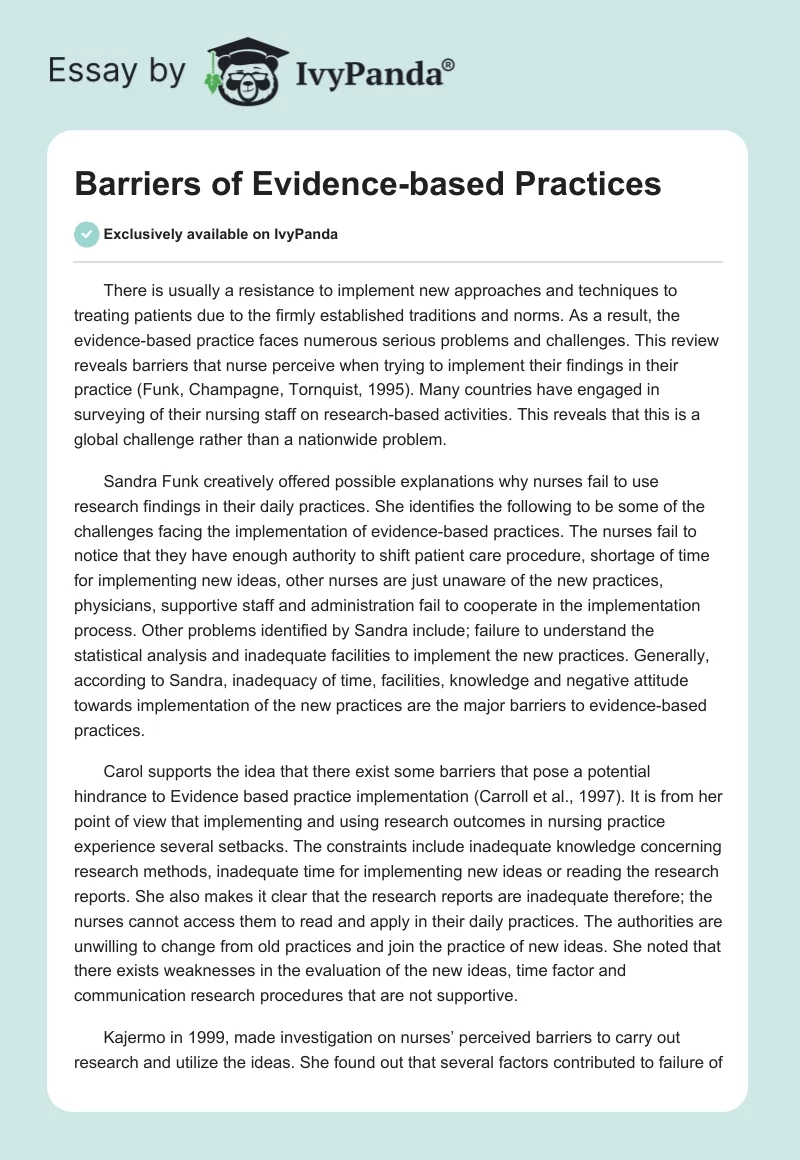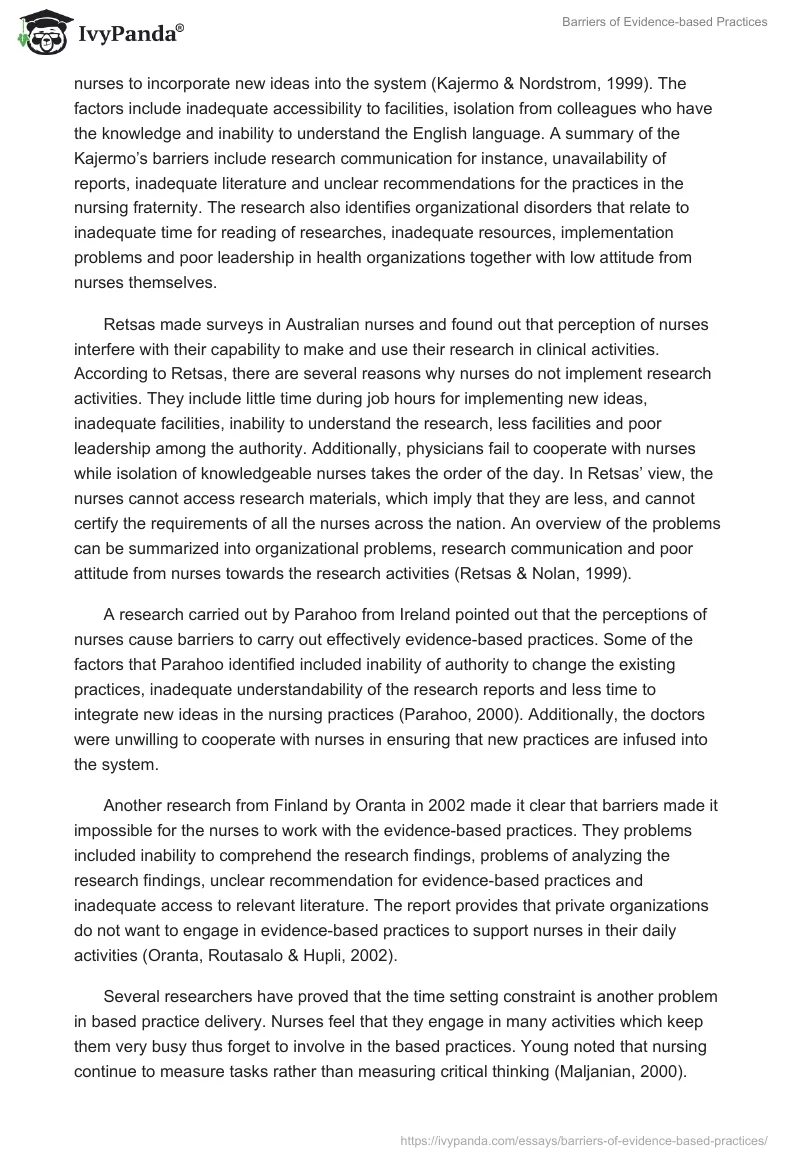There is usually a resistance to implement new approaches and techniques to treating patients due to the firmly established traditions and norms. As a result, the evidence-based practice faces numerous serious problems and challenges. This review reveals barriers that nurse perceive when trying to implement their findings in their practice (Funk, Champagne, Tornquist, 1995). Many countries have engaged in surveying of their nursing staff on research-based activities. This reveals that this is a global challenge rather than a nationwide problem.
Sandra Funk creatively offered possible explanations why nurses fail to use research findings in their daily practices. She identifies the following to be some of the challenges facing the implementation of evidence-based practices. The nurses fail to notice that they have enough authority to shift patient care procedure, shortage of time for implementing new ideas, other nurses are just unaware of the new practices, physicians, supportive staff and administration fail to cooperate in the implementation process. Other problems identified by Sandra include; failure to understand the statistical analysis and inadequate facilities to implement the new practices. Generally, according to Sandra, inadequacy of time, facilities, knowledge and negative attitude towards implementation of the new practices are the major barriers to evidence-based practices.
Carol supports the idea that there exist some barriers that pose a potential hindrance to Evidence based practice implementation (Carroll et al., 1997). It is from her point of view that implementing and using research outcomes in nursing practice experience several setbacks. The constraints include inadequate knowledge concerning research methods, inadequate time for implementing new ideas or reading the research reports. She also makes it clear that the research reports are inadequate therefore; the nurses cannot access them to read and apply in their daily practices. The authorities are unwilling to change from old practices and join the practice of new ideas. She noted that there exists weaknesses in the evaluation of the new ideas, time factor and communication research procedures that are not supportive.
Kajermo in 1999, made investigation on nurses’ perceived barriers to carry out research and utilize the ideas. She found out that several factors contributed to failure of nurses to incorporate new ideas into the system (Kajermo & Nordstrom, 1999). The factors include inadequate accessibility to facilities, isolation from colleagues who have the knowledge and inability to understand the English language. A summary of the Kajermo’s barriers include research communication for instance, unavailability of reports, inadequate literature and unclear recommendations for the practices in the nursing fraternity. The research also identifies organizational disorders that relate to inadequate time for reading of researches, inadequate resources, implementation problems and poor leadership in health organizations together with low attitude from nurses themselves.
Retsas made surveys in Australian nurses and found out that perception of nurses interfere with their capability to make and use their research in clinical activities. According to Retsas, there are several reasons why nurses do not implement research activities. They include little time during job hours for implementing new ideas, inadequate facilities, inability to understand the research, less facilities and poor leadership among the authority. Additionally, physicians fail to cooperate with nurses while isolation of knowledgeable nurses takes the order of the day. In Retsas’ view, the nurses cannot access research materials, which imply that they are less, and cannot certify the requirements of all the nurses across the nation. An overview of the problems can be summarized into organizational problems, research communication and poor attitude from nurses towards the research activities (Retsas & Nolan, 1999).
A research carried out by Parahoo from Ireland pointed out that the perceptions of nurses cause barriers to carry out effectively evidence-based practices. Some of the factors that Parahoo identified included inability of authority to change the existing practices, inadequate understandability of the research reports and less time to integrate new ideas in the nursing practices (Parahoo, 2000). Additionally, the doctors were unwilling to cooperate with nurses in ensuring that new practices are infused into the system.
Another research from Finland by Oranta in 2002 made it clear that barriers made it impossible for the nurses to work with the evidence-based practices. They problems included inability to comprehend the research findings, problems of analyzing the research findings, unclear recommendation for evidence-based practices and inadequate access to relevant literature. The report provides that private organizations do not want to engage in evidence-based practices to support nurses in their daily activities (Oranta, Routasalo & Hupli, 2002).
Several researchers have proved that the time setting constraint is another problem in based practice delivery. Nurses feel that they engage in many activities which keep them very busy thus forget to involve in the based practices. Young noted that nursing continue to measure tasks rather than measuring critical thinking (Maljanian, 2000). According to Farrell, these tasks are time imperatives in which patients are organized in tight schedule with strict tasks-time grids. Farrell observed that the schedule is meant to trap the nurses. It is from the writer’s point that the schedules appear in most of the healthcare centers. Maljanian acknowledged that the schedule works well in some of the health organizations. Maljanian concludes by proposing that an integration of best current activities with care practices can lead to evidence-based practices in nursing which are synonymous in caring. Commitment to task-time imperatives reduces time for nurses to envision and explore sound evidence as a benchmark for evidence-based practices.
Although nursing research started scientifically long time ago, the nursing profession is still struggling with ways of implementing the outcomes of the researches into the clinical practices. Young acknowledge the existence of nursing literature, nursing schools, Magnet hospitals, and evidence-based practice centers. It is from the researcher’s point of view that all the mentioned facilities can promote evidence-based practices. Young also identified that the approach to evidence-based practices are modeled in various nursing education areas. Matters that appear within current settings of clinical practice can easily affect nursing students. Young proposed that issues affecting implementation of evidence-based nursing approach within current nursing situations, must be dealt with nurse educators. They involve time factors, accessing of information and resources, nurses should research to gain skills and knowledge and introduce evidence-based practices into the current nursing tradition (Young, 2003).
Evidence-based practices can improve health care delivery to patients across the globe. It is unfortunate that existence of many challenges facing the effectiveness of the practice can render it unproductive. This calls for all stakeholders to step in and make more research and innovations to eliminate these barriers. It will enable nurses, physicians, doctors and co-workers to cooperate in serving patients using evidence-based practices.
References
Carroll, D.L. et al. (1997).”Barriers and facilitators to the utilization of nursing research,” Clinical Nurse Specialist, 11 (1), 207-212.
Funk, S., Champagne, M., Tornquist, E. (1995), “Administrators’ views on barriers to research utilisation”, Applied Nursing Research, 8 (1), 44-9.
Kajermo, K. & Nordstrom, G. (1999). Barriers to and facilitators of research utilization, as Perceived by a group of registered nurses in Sweden. J Adv Nurs.,27 (4), 798-807
Maljanian, R. (2000). Supporting nurses in their quest for evidence-based practice: Research utilization and conduct. Outcomes Management for Nursing Practice, 10 (4), 155-158.
Oranta, O., Routasalo, P., & Hupli, M., (2002). “Barriers to and facilitators of research utilization among Finnish registered nurses,” Journal of Clinical Nursing, 11 (1), 205-213.
Parahoo, K. (2000). Barriers to, and facilitators of, research utilization among nurses in Northern Ireland. Journal of Advanced Nursing, 31 (2), 89–98.
Paramonczyk, A. (2005). Barriers to implementing research in clinical practice. J Canadian Nurse, 101 (3), 12-15.
Retsas, A., Nolan, M. (1999). “Barriers to nurses’ use of research: An Australian hospital study,” International Journal of Nursing Studies, 36 (2), 335-343.
Young, K. M. (2003). Where’s the evidence? American Journal of Nursing, 103 (10), 11.


